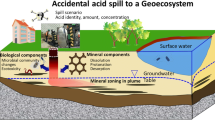Abstract
We expand the biogeochemical program CCBATCH to describe transport processes in 1-D ground-water systems. We use the expanded CCBATCH with our biogeochemical framework for metal detoxification in sulfidic systems to study complex bio-protection scenarios. In particular, in our numerical experiments we expose a consortium of sulfate-reducing bacteria and fermenting bacteria to a toxic concentration of Zn2+ in a 1-D system with precipitation of zinc-sulfide solids turned off or on. Our results confirm the key role of sulfide precipitation in detoxification when coupled effects of transport and biological processes are considered. The potential of sulfide as a detoxifying agent in bio-protection is explained by its high mobility, its high affinity for metals, and its high rate of production in sulfidic systems. Thus, our numerical results offer important evidence for the gradient-resistance mechanism and validate that a metal-resistance criterion developed from an analytical solution is accurate for defining when bio-protection should succeed.









Similar content being viewed by others
References
Benner SG, Blowes DW, Gould WD et al (1999) Geochemistry of a permeable reactive barrier for metals and acid mine drainage. Environ Sci Technol 33(16):2793–2799
Benner SG, Blowes DW, Ptacek CJ, Mayer KU (2002) Rates of sulfate reduction and metal sulfide precipitation in a permeable reactive barrier. Appl Geochem 17:301–320
Blowes DW, Ptacek CJ, Benner SG et al (2000) Treatment of inorganic contaminants using permeable reactive barriers. Contam Hydrol 45:123–137
Campbell PGC (1995) Interactions between trace metals and organisms: critique of the free-ion activity model. In: Tessier A, Turner D (eds) Metal speciation and bioavailability in aquatic systems. Wiley, Chichester, UK
Campbell PGC, Errecalde O, Fortin C, Hiriart-Baer VP, Vigneault B (2002) Metal bioavailability to phytoplankton – applicability of the biotic ligand model. Comp Biochem Physiol Part C 133:189–206
Kirkner DJ, Reeves H (1988) Multicomponent mass transport with homogeneous and heterogeneous chemical reactions: effect of the chemistry on the choice of numerical algorithm, 1. Theory. Water Resour Res 24(10):1719–1729
Paquin PR, Gorsuch JW, Apte S et al (2002) The biotic ligand model: a historical overview. Comp Biochem Physiol Part C 133:3–35
Rittmann BE, McCarty PL (2001) Environmental biotechnology: principles and applications. McGraw-Hill, New York
Schwarz AO, Rittmann BE (2007) A biogeochemical framework for metal detoxification in sulfidic systems. Biodegradation (in press). doi: 10.1007/s10532-007-9101-2
Schwarz AO, Rittmann BE (2006) Analytical-modeling analysis of how pore-water gradients of toxic metals confer community resistance. Adv Water Res (in press). doi: 10.1016/j.advwatres.2006.05.015
Steefel CI, Lasaga AC (1994) A coupled model for transport of multiple chemical species and kinetic precipitation/dissolution reactions with application to reactive flow in single phase hydrothermal systems. Am J Sci 294:529–592
Stumm W, Morgan JJ (1996) Aquatic chemistry. John Wiley & Sons, New York
Tebes-Stevens C, Valocchi AJ, Van Briesen JM, Rittmann BE (1998) Multicomponent transport with coupled geochemical and microbiological reactions: model description and example simulations. J Hydrol 209:8–26
Waybrant KR, Ptacek CJ, Blowes DW (2002) Treatment of mine drainage using permeable reactive barriers: column experiments. Environ Sci Technol 36:1349–1356
Author information
Authors and Affiliations
Corresponding author
Rights and permissions
About this article
Cite this article
Schwarz, A.O., Rittmann, B.E. Modeling bio-protection and the gradient-resistance mechanism. Biodegradation 18, 693–701 (2007). https://doi.org/10.1007/s10532-007-9106-x
Received:
Accepted:
Published:
Issue Date:
DOI: https://doi.org/10.1007/s10532-007-9106-x




